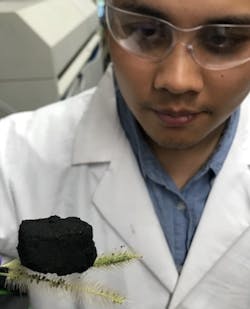Rice University develops conductive laser-induced-graphene foam from plastic (with video)
Rice University (Houston, TX) scientists have developed a simple way to produce conductive, three-dimensional (3D) objects made of graphene foam. The squishy solids look and feel something like a child’s toy but offer new possibilities for energy storage and flexible electronic sensor applications, according to Rice chemist James Tour.
RELATED ARTICLE: Rice University chemists make conductive laser-induced graphene from wood
The technique detailed in Advanced Materials is an extension of work by the Tour lab that produced the first laser-induced graphene (LIG) in 2014 by heating inexpensive polyimide plastic sheets with a laser. The laser burns halfway through the plastic and turns the top into interconnected flakes of 2D carbon that remain attached to the bottom half. LIG can be made in macroscale patterns at room temperature.
The lab extended its technique to create LIG on wood and even food, but 3D objects of pure graphene were less practical until now, Tour said. "Now we have built a prototype machine that lets us make graphene foam into 3D objects through automated successive layering and laser exposure," Tour said. "This truly brings graphene into the third dimension without furnaces or the need for metal catalysts, and our process is easily scaled [see video below]."
The new method is based on laminated object manufacturing, in which layers of a material are assembled and then cut to shape. In this case, the bottom LIG layer remains attached to its polyimide base. A second layer is coated with ethylene glycol and placed facedown on the first, like a jelly sandwich. Its polyimide top is then burned into graphene; the process is repeated until the block is complete.
The ethylene glycol binder is evaporated away on a hot plate, and any remaining polyimide can be removed in a furnace. That leaves a pristine, spongy carbon block, said Duy Xuan Luong, a Rice graduate student and co-lead author of the paper. The Rice lab stacked up to five layers of foam and then used a custom-built fiber lasing system on a modified 3D printer to mill the block into complex shapes.
The lab assembled proof-of-concept lithium-ion capacitors that used 3D LIG as both anodes and cathodes. "This is excellent performance in these new-generation lithium-ion capacitors, which capture the best properties of lithium-ion batteries and capacitor hybrids," Tour said.
The researchers then infused a block of 3D LIG with liquid polydimethylsiloxane through its 20- to 30-nm pores. This created a stronger, still-flexible, conductive graphene material without changing the original foam’s shape. From this material, they made a flexible sensor that accurately recorded the pulse from the wrist of a volunteer and said further calibration of the device would let them extract blood pressure from the pulse waveform.
The Air Force Office of Scientific Research and the Vietnam Education Foundation supported the research.
SOURCE: Rice University; http://news.rice.edu/2018/06/14/sculpting-with-graphene-foam-2/
About the Author

Gail Overton
Senior Editor (2004-2020)
Gail has more than 30 years of engineering, marketing, product management, and editorial experience in the photonics and optical communications industry. Before joining the staff at Laser Focus World in 2004, she held many product management and product marketing roles in the fiber-optics industry, most notably at Hughes (El Segundo, CA), GTE Labs (Waltham, MA), Corning (Corning, NY), Photon Kinetics (Beaverton, OR), and Newport Corporation (Irvine, CA). During her marketing career, Gail published articles in WDM Solutions and Sensors magazine and traveled internationally to conduct product and sales training. Gail received her BS degree in physics, with an emphasis in optics, from San Diego State University in San Diego, CA in May 1986.
